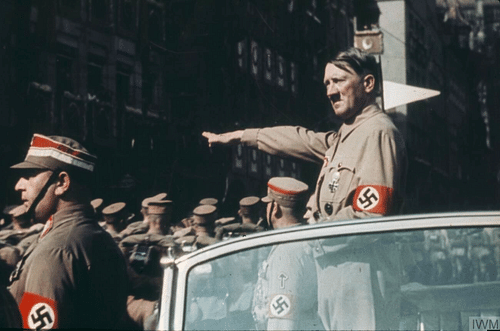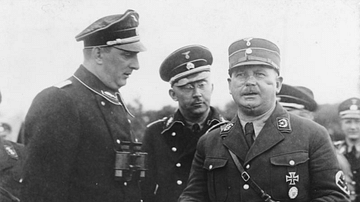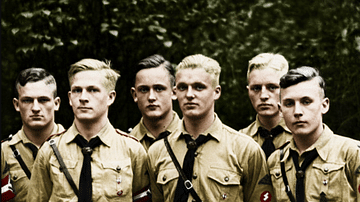
The Sturmabteilung (SA or Storm Detachment), popularly known as the Brownshirts for their uniform, was the paramilitary arm of the German Nazi party led by Adolf Hitler (1889-1945). The SA was formed in 1921 and led most famously by Ernst Röhm (1887-1934) with the purpose of intimidating rival parties and attacking those identified as enemies of Nazism.
Hitler grew wary of the growing power of the SA, and, embarrassed by its lawlessness after he became chancellor of Germany in 1933, he had Röhm and key SA figures assassinated on 30 June 1934, an event known as the Night of the Long Knives. The functions of the SA, such as running concentration camps, were taken over by another Nazi paramilitary group, the SS (Schutzstaffel)
The SA's Function & Leadership
Hitler had become the leader of the Munich-based NSDAP (National Socialist German Workers' Party) in 1921. The party was neither socialist nor at all interested in workers, but Hitler had chosen the name to give his ultra-nationalist party as wide an appeal as possible. Known as the Nazi party, it was also vehemently anti-Semitic and against the German establishment.
The SA or Sturmabteilung paramilitary group was officially formed in 1921. As Hitler had said, "We must struggle with ideas, but if necessary also with fists" (Hite, 116). He might have added, too, the traditional weapons of the SA: the rubber truncheon, metal piping, and knuckleduster. The SA men were not given firearms since this would make them a rival to the army, which Hitler needed the support of if he was ever to take power. In 1921, Hitler himself led one vicious SA attack on a rival politician who was giving a speech in Bavaria. Hitler was arrested and spent one month in prison for the assault. With his popularity unharmed by the incident, Hitler remarked that "The Nationalist Socialist Movement will in the future ruthlessly prevent – if necessary by force – all meetings or lectures that are likely to distract the minds of our fellow countrymen" (Shirer, 43).

The SA was given several functions to further the Nazi cause:
- to protect Nazi party gatherings and meetings
- to distribute Nazi propaganda such as posters and fliers
- to rough up rival political parties and rival paramilitary groups
- to intimidate voters at polling booths
- to terrorise enemies in general (especially Jewish people and rival political activists) through physical attacks in the streets, arrests, and, in secret, to carry out beatings and torture
- to make the Nazis look successful, disciplined, and important.
The first leader of the SA was Hans Ulrich Klintzsch (1898-1959), a former naval lieutenant. Hermann Göring (1893-1946), the First World War (1914-18) airforce hero, was selected to lead the SA from March 1923 because Hitler thought his reputation would gain a boost in recruits. From May 1924, the next leader of the SA was Ernst Röhm, a short, stocky, ruthless man, who carried impressive facial scars from wounds sustained in WWI. Röhm had been instrumental in forming the "gymnastics and sports" branch of the Nazi party, which had then morphed into the SA.
The SA's Uniform & Membership
The SA wore German army surplus uniforms, indeed, many of their members had served in the armed forces. From 1924, the SA began to wear the army's tropical issue uniform, hence their nickname, the Brownshirts. This uniform became mandatory from 1926. The adoption of a brown uniform gave the SA a distinctive look, just as the Italian fascist dictator Benito Mussolini (1883-1945) had earlier done with his own paramilitary group, the Blackshirts. SA members also wore the Nazi party swastika flag as an armband. Respect for the uniform and just how to behave when wearing it was stipulated by such edicts as the "Ten Commandments of the Storm Troopers":
The brown shirt is a garment of honour. The wearer must above all represent the National Socialist worldview and conduct himself appropriately. When the Storm Trooper assembles for a march, it is especially important that he not have his hands in his pockets or a cigarette in his mouth.
(Range, 176)
SA members, who were all volunteers, came from all sections of society. The majority of recruits were men between the ages of 18 and 35. Although the working class was the most represented social group within the SA, police records show that a significant proportion of stormtroopers came from the middle class. Many SA recruits had previously been members of youth groups and other paramilitary groups like the Freikorps. As the historian F. McDonough notes: "It is very important to emphasise that violence in Germany did not start with Hitler and the Nazis. They magnified something that had become an integral part of Weimar political culture" (9).
When SA members were killed in action, the party propaganda machine got to work and spewed out articles on the fallen, describing them again and again as martyrs. One young SA Nazi, Horst Wessel, was killed fighting Communists in 1930. A poem Wessel had written was set to music – the Horst Wessel Song – and became the SA's anthem. Hitler himself often gave speeches at the funerals of SA stormtroopers.

SA members were very often drifters, the unemployed, or those who simply wanted to join an organisation they felt could improve Germany. Free food and lodgings inspired many young men to join. Some recruits were ideologically motivated such as a hatred of Jewish people and Communists. The uniform, ranking system, the speeches of Hitler, and the fact that SA groups were usually based in a local tavern were other sources of appeal. Like any group, there was, too, a feeling of belonging and camaraderie. Members helped each other such as in the scheme to buy the SA's own brand of cigarettes with the profits going to those troopers who had been seriously injured in the all-too-common violent clashes with rival party groups. Finally, there were those simply addicted to the power and opportunities for sadistic violence the SA could provide, not only in its street battles with left-wing political rivals like the Red Fighting League of the Communist Party (KPD) but also in the detention of the innocent and the unseen beatings and torture carried out in secret cellars, which only grew in frequency as the Nazis gained political power.
The SA was almost too successful, and its growing membership in the early 1920s put Hitler on the alert. The Nazi leader decided to create his own personal bodyguard, a much smaller but more loyal group called the Stosstrupp-Hitler (Hitler Shock Troop). Nevertheless, the SA was involved in the infamous Beer Hall Putsch or Munich Putsch, the failed Nazi coup in November 1923. After the failure of the putsch, Hitler and his leading associates, including Röhm, were found guilty of treason and imprisoned, albeit for what turned out to be short sentences. The immediate fallout of the putsch was a setback as the Nazi party and the SA were banned temporarily (the organisation was again banned temporarily in 1932), and the Stosstrupp-Hitler was disbanded. However, the publicity of the court case against Hitler and his excellent oratory skills actually increased interest in both the Nazi cause and the SA. Temporarily called the Frontbann while it was banned, Röhm, with Hitler's blessing, oversaw a huge rise in SA membership from 2,000 in 1923 to 30,000 stormtroopers in 1924.
Rivalry with the SS
Wary of Röhm and the SA's power, in 1925, Hitler created a rival paramilitary group, the Schutzstaffel or SS, which was loyal to Hitler personally. In this early period, Hitler employed the SS organisation as 'protection squads', his personal bodyguard, as a sort of party police, and for generally demonstrating Nazi power in public. From January 1929, the SS was led by Heinrich Himmler (1900-1945), a veteran of the Munich Putsch who would oversee a gigantic expansion of the SS in the following years.
As part of this reorganisation of the Nazi party's enforcers, Röhm was removed as head of the SA in May 1925. Hitler, concerned at Röhm's ambitions to create a revolutionary military organisation that could rival the German army (which was limited in size by the Treaty of Versailles to 100,000 men), now took personal control of the SA. Röhm, meanwhile, went off to Bolivia for the next five years. The new SA leader from 1926, chosen by Hitler, was Franz Pfeffer von Salomon (1888-1968), a position he held until 1929.
By 1929, the SA had 100,000 members. Otto Wagener (1888-1971) headed the SA for a period, but Röhm was reinstated as the organisation's chief in January 1931. By now, with their election performances being less than hoped for, Hitler was more willing to build up the military muscle of the Nazi party. Accordingly, by 1933, the SA boasted 2.3 million members.
The SA and SS became rivals and frequently clashed. The most infamous confrontation came in 1930-1 with the Stennes revolt when the SS put down a revolt in Berlin by that city's SA troops. It was an ominous warning of how unruly the SA could be.
The SA had already been running small detention centres, often in cellars, where opponents of the Nazis could be dealt with quietly. Concentration camps were then set up when the Nazis took power in 1933. Two of the larger camps were Nohra in Thuringia and Oranienburg in Prussia. The SA was charged with running these camps, which grew steadily in number. Here the Nazis sent their political enemies and any other people they considered 'undesirables'. People sent to the camps were very often detained without trial. The SS took over the management of concentration camps in May 1934.
Attacks on the Nazi's Enemies
The SA remained a useful organisation for Hitler's purposes throughout the early 1930s, especially when some out-of-uniform anonymous thuggery was required, which he could, in public, maintain a respectable distance from. The historian S. Friedländer gives the following summary of just one episode of SA violence against Jewish people when, as was usual, the state services stood by or even assisted:
About thirty SA men from Heilbronn arrived in Niederstetten, a small town in southwest Germany, on Saturday, March 25, 1933. Breaking into the few Jewish homes in the area, they took the men to the town hall and savagely beat them while local policemen kept watch at the building entrance. The scene was repeated that morning in neighbouring Creglingen, where the eighteen male Jews found in the synagogue were also herded into the town hall. There the beatings led to the deaths of sixty-seven-year-old Hermann Stern and, a few days later, fifty-three-year-old Arnold Rosenfield. (41)

On the rare occasions when SA members faced criminal charges for their outrageous violence, Hitler privately supported them and sometimes publicly renounced the authorities concerned as being manipulated by Jews. One such example is the five SA members charged with murdering the pro-Communist worker Konrad Piecuch in August 1932. When the five stormtroopers were found guilty and sentenced to death, Hitler wrote them the following telegram:
My comrades! In view of this incredible criminal verdict I feel myself tied to you in unlimited fidelity. From this moment on, your freedom is our honour, the fight against a government under which such a thing was possible, our duty.
(Friedländer, 111)
Although not winning a majority of seats in parliament, the Nazi party had been successful enough in the 1932 election for Hitler to be invited to become the chancellor of Germany. Without a clear majority party, another election was called for 1933. The SA continued to be used to intimidate political rivals. The Reichstag Fire of 27 February 1933, when the German parliament was set ablaze, was supposedly caused by a Communist Marinus van der Lubbe, although it may have been a Sturmabteilung operation since Hitler was keen to add to many people's already healthy suspicion of Communists by implicating the movement in anarchist acts. In the elections of March 1933, the SA continued its usual activity of inhibiting the campaigns of rival parties and intimidating voters at the polling stations. The Nazis gained 44% of the votes in the election.
Night of the Long Knives
Hitler, with his position strengthened, no longer needed the embarrassment of the thuggish SA since, as chancellor, he had the protection of the German army. In any case, the SA had become too powerful for its own good. To keep the support of the army, which saw the SA as a dangerous rival to its own function in the state, Röhm and the SA were accused, without any evidence, of plotting a revolution against the fledgling Nazi regime. Röhm's homosexuality had never bothered Hitler before, but now it was used as another excuse for the purge. So began a ruthless cull, known as the Blood Purge or Night of the Long Knives, but actually a period of in-party violence spanning from 29 June to 1 July 1934. The Nazis called their purge, which was carried out by the SS across Germany and Austria, Operation Hummingbird.
Röhm was arrested in Bad Wiessee, roused from his bed and put in a cell in the Stadelheim Prison in Munich. Another 110 SA leaders were identified for execution. On 1 July, Röhm was offered a pistol to shoot himself with, but he refused. Either Theodor Eicke or Michael Lippert shot the former SA leader. Then Dr Hans Frank (1900-1946), the Nazi's leading expert in law, raised concerns over the legal implications of the planned executions. Another 20 executions were carried out despite the legal concerns. Hitler used the chaos of the purge to also eliminate other rivals and threats to his power, people with no links at all to the Sturmabteilung. In all, 478 people were murdered in the purge. The most prominent non-Nazi figures who were executed included the politician Gregor Strasser (1892-1934) and General Kurt von Schleicher (1882-1934) and his wife. Many deaths, like Strasser's, were reported as suicide.
Although the SA was never the same organisation again after the Night of the Long Knives, it was still used, under a new commander, Viktor Lutze (1890-1943), to attack anyone the Nazi regime deemed a threat. The most notorious episode of SA violence was the Kristallnacht (Reichkristallnacht) or 'Night of Broken Glass', when SA members attacked Jewish people and property across Germany and Austria on 9-10 November 1938.








